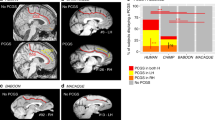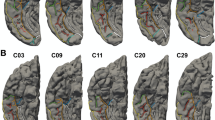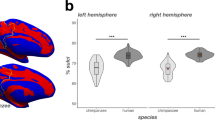Abstract
Sulcal patterns were determined from endocasts of fossilTheropithecus (T. oswaldi andT. darti) and compared to the sulcal pattern of extant geladas (T. gelada). A comparison of the configurations of central and arcuate sulci suggests that the cortical motor face representation is relatively enlarged in extantTheropithecus, whereas the cortical motor and sensory face representations were enlarged inT. oswaldi. A relatively expanded sensory and/or motor cortical face representation may be related to masticatory (e.g., “seed-eating”) and gestural (e.g., “lipflip”) functions. SinceT. oswaidi is more derived (expanded) in sensory face representation thanT. gelada, it seems unlikely that it was a direct ancestor of modern geladas. Rather, the two groups were separate by 1.8 million years ago and may have had a most recent common ancestor similar toT. darti from the Hadar Formation of Ethiopia between 2 and 3 million years ago.
Similar content being viewed by others
References
Andrews, C. W. (1916). Note on a new baboon (Simopithecus oswaldi, gen, et sp. n.) from the (?) Pliocene of British East Africa.Ann. Mag. Nat. Hist. (London) 18: 410–419.
Aronson, J. L., Schmitt, T. J., Walter, R. C., Taieb, M., Tiercelin, J. J., Johanson, D. C., Naeser, C. W., and Nairn, A. E. M. (1977). New geochronologic and palaeomagnetic data for the hominid-bearing Hadar formation of Ethiopia.Nature 267: 323–327.
Cerling, T. E., Brown, F. H., Cerling, V. W., Curtis, G. H., and Drake, R. E. (1979). Preliminary correlations between the Koobi Fora and Shungura formations, East Africa.Nature 279: 118–121.
Connolly, C. J. (1950).External Morphology of the Primate Brain, Thomas, Springfield, Ill.
Crosby, E., Humphrey, T., and Lauer, E. (1962).Correlative Anatomy of the Nervous System, Macmillan, New York.
Curtis, G. H., Drake, R., Cerling, T., and Hampel, J. (1975). Age of KBS tuff in Koobi Fora formation, East Rudolf, Kenya.Nature 258: 395–398.
Delson, E. (1977). Catarrhine phylogeny and classification: Principles, methods and comments.J. Hum. Evol. 6: 433–459.
Eck, G. (1976). Cercopithecoidea from Omo Group deposits. In Coppens, Y., Howell, F. C., Isaac, G. L., and Leakey, R. E. F., (eds.),Earliest Man and Environments in the Lake Rudolf Basin, University of Chicago Press, Chicago, pp. 332–344.
Eck, G. (1977). Diversity and frequency distribution of Omo Group Cercopithecoidea.J. Hum. Evol. 6: 55–63.
Falk, D. (1978a). Brain evolution in Old World Monkeys.Am. J. Phys. Anthropol. 48: 315–320.
Falk, D. (1978b). External neuroanatomy of Old World monkeys (Cercopithecoidea).Contributions to Primatology, Vol. 15, Karger, Basel.
Falk, D. (1980). Comparative study of the endocranial casts of New and Old World monkeys. In Chiarelli, B., and Ciochon, R. L. (eds.),Evolutionary Biology of the New World Monkeys and Continental Drift, Plenum Press, New York, pp. 275–292.
Freedman, L. (1957). The fossil Cercopithecoidea of South Africa.Annals of the Transvaal Museum, Vol. 23, University Press, Cambridge.
Freedman, L. (1976). South African fossil Cercopithecoidea: A re-assessment including a description of new material from Makapansgat, Sterkfontein and Taung.J. Hum. Evol. 5: 297–315.
Hillhouse, J. W., Ndombi, J. W. M., Cox, A., and Brock, A. (1977). Additional results on palaeomagnetic stratigraphy of the Koobi Fora formation, east of Lake Turkana (Lake Rudolf), Kenya.Nature 265: 411–415.
Howell, F. C., and Coppens, Y. (1974). Inventory of remains of Hominidae from Plio/ Pleistocene formations of the lower Omo basin, Ethiopia (1967–1972).Am. J. Phys. Anthropol. 40: 1–16.
Jolly, C. J. (1970). The seed eaters: A new model of hominid differentiation based on a baboon analogy.Man 5: 5–26.
Jolly, C. J. (1972). The classification and natural history ofTheropithecus (Simopithecus) (Andrews, 1916), baboons of the African Plio-Pleistocene.Bull. Br. Mus. Nat. Hist. Geol. 22.
Klein, R. G. (1973). Geological antiquity of Rhodesian man.Nature 244: 311–312.
Leakey, M. G., and Leakey, R. E. F. (1973). Further evidence ofSimopithecus (Mammalia, Primates) from Olduvai and Olorgesailie.Foss. Vert. Africa 3: 101–120.
Napier, J. R., and Napier, P. H. (1967).A Handbook of Living Primates, Academic Press, New York.
Radinsky, L. B. (1968). A new approach to mammalian cranial analysis, illustrated by examples of prosimian primates.J. Morphol. 124: 167–180.
Radinsky, L. B. (1972). Endocasts and studies of primate brain evolution. In Tuttle, R. H. (ed.),The Functional and Evolutionary Biology of Primates, Aldine, Chicago, pp. 175–184.
Richman, B. (1976). Some vocal distinctive features used by gelada monkeys.J. Acoust. Soc. Am. 60: 718–724.
Simons, E. L. (1972).Primate Evolution, Macmillan, New York.
White, T. D., and Harris, J. M. (1977). Suid evolution and correlation of African hominid localities.Science 198: 13–21.
Woolsey, C. N. (1958). Organization of somatic sensory and motor area of the cerebral cortex. In Harlow, H. F., and Woolsey, C. N. (eds.),Biological and Biochemical Bases of Behavior, University of Wisconsin Press, Madison, pp. 63–81.
Woolsey, C. N. (1964). Cortical localization as defined by evoked potential and electrical stimulation studies. In Schaltenbrand, G., and Woolsey, C. N. (eds.),Cerebral Localization and Organization, University of Wisconsin Press, Madison, pp. 17–26.
Author information
Authors and Affiliations
Rights and permissions
About this article
Cite this article
Falk, D. Sulcal patterns of fossilTheropithecus baboons: Phylogenetic and functional implications. Int J Primatol 2, 57–69 (1981). https://doi.org/10.1007/BF02692300
Received:
Revised:
Issue Date:
DOI: https://doi.org/10.1007/BF02692300




